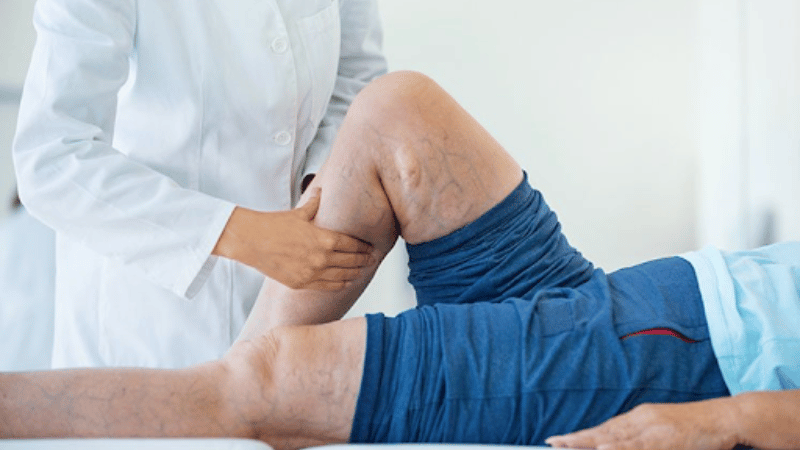If your physician has ever recommended you to see a vascular surgeon or interventional radiologist, you may be a bit confused about what that entails. Despite their seemingly distinct fields of medical expertise, there is actually a significant overlap in the kinds of procedures they perform.
Peripheral artery disease (PAD), also referred to as peripheral vascular disease, occurs when plaque accumulation within the arteries causes limited blood flow. When blood carrying oxygen and nutrients fails to reach the lower extremities such as the legs and feet, it may cause painful symptoms. Unlike coronary artery disease, PAD affects the lower half of your body’s arteries such as the iliac, femoral, aorta, popliteal, or tibial.
With various treatment options available, it’s crucial to understand the roles of different specialists who manage PAD. Two key players in this field are vascular surgeons and interventional radiologists. Each brings unique expertise to the table, making it important to know whom to consult for your specific needs.
What Is a Vascular Surgeon?
A vascular surgeon, sometimes called a vascular specialist, manages and treats veins and arteries in every part of the body except the brain or heart. A vascular surgeon can treat conditions like:
- Deep vein thrombosis (DVT) and other blood clots
- Vein disease and venous insufficiency
- Atherosclerosis, like peripheral artery disease (PAD)
- Critical limb ischemia
- Diabetes vascular disease and limb salvage
- Diseases of the aorta
- Dialysis graft and fistula management
- Non-healing wounds caused by vascular disease
Understanding Vascular Surgeon Specializations
Although vascular surgeons can treat numerous arterial and venous diseases, their approach depends on their area of specialization and the resources and technology available to them. Therefore, it’s important to choose a vascular surgeon with a specialty in your condition. Vascular surgeons are trained to treat various conditions because most vascular diseases share a common origin: declining blood vessel health. By addressing the root problem, vascular surgeons can help prevent serious and life-threatening arterial diseases.
Vascular Surgeons and PAD
Severe cases of PAD might require surgical intervention, such as angioplasty or bypass surgery, when non-surgical methods are not effective.
Angioplasty involves widening narrowed arteries using a balloon, while bypass surgery creates a new pathway for blood flow around a blocked artery using a graft. The choice of procedure is influenced by the severity of symptoms, the patient’s overall health, and the extent of arterial blockages.
Vascular surgeons usually use a combination of lifestyle changes, medications, and minimally invasive treatments to help patients avoid surgery unless it becomes necessary.
Are Cardiothoracic and Vascular Surgeons the Same?
A cardiothoracic surgeon is a physician specializing in surgical procedures involving the heart, lungs, and other organs within the chest. A vascular surgeon, on the other hand, is a broader title that includes specialists who may also be cardiothoracic surgeons, but not always. Both types of surgeons commonly treat coronary artery disease, a condition caused by plaque buildup in the coronary arteries that can lead to a heart attack. Despite their different specializations, both are skilled in unclogging blocked arteries to restore blood flow.
Many cardiothoracic surgeons also treat PAD because it shares a similar cause–arterial plaque accumulation. Their approach to treating PAD can be surgical or non-surgical, depending on their training and expertise.
What Is an Interventional Radiologist?
Interventional radiologists (IR) are classified by their ability to diagnose and treat diseases with image-guided tools such as a fluoroscopy or a live x-ray. Vascular surgeons can double as interventional radiologists with the right training. By utilizing image-guided tools and techniques, interventional radiologists can perform a wide variety of non-surgical, minimally invasive treatments and tests, such as:
- Angiography
- Stent angioplasty
- Chemoembolization
- Uterine fibroid embolization (UFE)
- Thrombolysis
- Biopsy
- Ablation
Image-Guided Treatments for Vascular Conditions
To reach these areas in the body, interventional radiologists use tiny catheters, needles, and other instruments in combination with image-guided tools. This allows them to put minimal pressure on other organs, which usually decreases the recovery time and procedural risk. At USA Vascular Centers, interventional radiologists treat peripheral artery disease using minimally invasive techniques.
Interventional radiologists can treat venous disease and other conditions like uterine fibroids non-surgically as well. Their technique for fibroids involves targeting the arteries that supply the fibroid and cutting off its blood supply through a minimally invasive approach.
SCHEDULE A CONSULTATION ONLINE
Interventional Radiologists and PAD
Interventional radiologists use angiography and stent angioplasty to treat PAD effectively. Angiography involves injecting a contrast dye into the bloodstream and using X-ray imaging to visualize blood vessels, helping to pinpoint areas of blockage or narrowing.
Stent angioplasty follows, where a tiny balloon stent is placed non-surgically into the affected artery, pushing the plaque buildup toward the sides of the artery. When the balloon is inflated, it creates a clear passageway for blood to flow freely to the extremities.
This combination of techniques allows for precise, minimally invasive treatment for PAD, often leading to quicker recovery times and fewer complications compared to traditional surgical approaches.
Do Interventional Radiologists Perform Surgery?
Interventional radiologists typically do not perform traditional open surgery. Instead, they use minimally invasive techniques guided by imaging tools to treat the issue at hand. This approach reduces recovery time, pain, and risks associated with conventional surgeries.
“Practicing interventional radiology reduces the cost, recovery time, pain, and risk to patients who would otherwise need traditional open surgery to treat their health condition,” said Yan Katsnelson, CEO and Founder of USA Vascular Centers.
IR procedures can be performed in an office-based setting, enabling patients to recover comfortably in their own homes. More patients are now opting for nonsurgical procedures when they can be offered.
What Kind of Doctor Treats PAD?
Doctors who treat PAD typically avoid surgery and opt for a combination of lifestyle, medicinal, and nonsurgical procedures. Since stent angioplasties are done non-surgically via live ultrasound guidance, the doctors who treat peripheral artery disease are known as interventional radiologists.
Even though the title “vascular surgeons” implies they perform surgical procedures, that is not always the case. Many vascular surgeons are also interventional radiologists, as they can go hand-in-hand, especially when treating PAD. Top vascular surgeons often are experienced in both vascular surgery and interventional radiology to be able to treat a large range of arterial diseases.
Finding a Vascular Surgeon or Interventional Radiologist Near You
While both vascular surgeons and interventional radiologists are dedicated to treating arterial conditions and women’s health conditions using non-surgical methods, there are distinct differences between them.
USA Vascular Centers works with only the top vascular surgeons and interventional radiologists to bring expert care from initial consultation to a successful recovery. With countless outpatient facilities nationwide, we aim to make receiving vascular or interventional radiology treatment as accessible and convenient as possible.
If you’re experiencing vascular issues related to peripheral artery disease, our centers can accommodate your needs. Call 888.773.2193 or schedule your initial consultation online.




